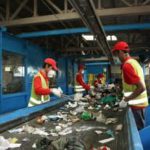 Americans use 85,000,000 tons of paper a year; about 680 pounds per person (more than anyone else in the world). The average household throws away 13,000 separate pieces of paper each year. Most are packaging and junk mail. In 1993, U.S. paper recovery saved more than 90,000,000 cubic yards of landfill space
Americans use 85,000,000 tons of paper a year; about 680 pounds per person (more than anyone else in the world). The average household throws away 13,000 separate pieces of paper each year. Most are packaging and junk mail. In 1993, U.S. paper recovery saved more than 90,000,000 cubic yards of landfill space
Paper production from recycled fibers consumes less energy and conserves the natural resources (wood) and decreases the environmental pollution.
Perchance the whole act of recycling may just be one that lulls us into a false sense of righteousness that empowers us to devour more materials goods without the guilt. 
However, paper recycling remains the way to go.
1.  Paper is taken from the bin and deposited in a large recycling container along with paper from other recycling bins.
Paper is taken from the bin and deposited in a large recycling container along with paper from other recycling bins.
2.  The paper is taken to a recycling plant where it is separated into types and grades.
The paper is taken to a recycling plant where it is separated into types and grades.
3.  The separated paper is then washed with soapy water to remove inks, plastic film, staples, and glue. The paper is put into a large holder where it is mixed with water to create ‘slurry’.
The separated paper is then washed with soapy water to remove inks, plastic film, staples, and glue. The paper is put into a large holder where it is mixed with water to create ‘slurry’.
4. By adding different materials to the slurry, different paper products can be created, such as cardboard, newsprints or office paper.
5. The slurry is spread using large rollers into large thin sheets.
6.  The paper is left to dry, and then it is rolled up ready to be cut and sent back to the shops.
The paper is left to dry, and then it is rolled up ready to be cut and sent back to the shops.
Reference
http://www.recycling-guide.org.uk/science-paper.html